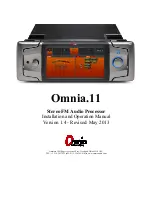
15 Instruction Set Reference
15 – 4
CAPITAL LETTERS
Capital letters denote a literal in the instruction.
Literals are the instruction name (e.g. ADD),
register names, or operand selections. Literals
must be typed exactly as shown.
operands
Some instruction operands are shown in
lowercase letters. These operands may take
different values in assembly code. For example,
the operand yop may be one of several registers:
AY0, AY1, or AF.
<exp>
Denotes exponent (shift value) in Shift Immediate
instructions; must be an 8-bit signed integer
constant.
<data>
Denotes an immediate data value. Can also be a
symbol (address label or variable/buffer name)
dereferenced by the ‘%’ or ‘^’ operators.
<addr>
Denotes an immediate address value to be
encoded in the instruction. The <addr> may be
either an immediate value (a constant) or a
program label.
<reg>
Refers to any accessible register; see Table 15.7.
<dreg>
Refers to any data register; see Table 15.7.
Immediate values, <exp>, <data>, or <addr>, may be a constant in
decimal, hexadecimal, octal or binary format. Default is to decimal.
15.4
MULTIFUNCTION INSTRUCTIONS
Multifunction operations take advantage of the inherent parallelism of the
ADSP-2100 family architecture by providing combinations of data moves,
memory reads/memory writes, and computation, all in a single cycle.
15.4.1
ALU/MAC With Data & Program Memory Read
Perhaps the single most common operation in DSP algorithms is the sum
of products, performed as follows:
• Fetch two operands (such as a coefficient and data point)
• Multiply the operands and sum the result with previous products
















































